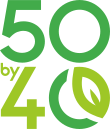In Conversation with Sinergia Animal
Financial institutions across the world play an essential role when it comes to bringing about complete landscape shifts in the way a myriad of businesses operate. They have the power to dictate the growth and downfall of industries through how they invest in them. A few of these industries are known to propagate some of the worse forms of animal cruelty. Since financial institutions finance such enterprises using money accumulated from their clients in the form of loans and investments, the clients indirectly fund animal cruelty unknowingly.
Building on this premise is Bank for Animals, a unique campaign initiated by Sinergia Animal to bring transparency to how financial institutions operate by assessing their policies affecting animal welfare.
50by40, in conversation with Merel van der Mark from Sinergia Animal, tries to get a deeper understanding of the campaign and how it tries to bring a systemic change in the animal welfare and sustainable food systems movement.

Can you give a brief introduction to the campaign?
Merel: The Banks for Animals campaign is primarily inspired by the work done by climate campaigners. Climate campaigners have long been focusing on the role of financiers and engaging with them to improve policies- since they have leverage when it comes to bringing about systemic changes. Sinergia Animal has some prominent programmes with the ultimate goal of animal protection and in due time, we realised the financial sector’s role in dictating animal welfare levels in the livestock sector. Further research brought to light the complete lack of transparency in how the financial industry operates, especially concerning funding animal agriculture, thus giving birth to the Bank for Animals campaign.
Launched in 2021, the campaign’s primary goal is to raise awareness about the policies (or the lack of them) of banks and investors worldwide regarding credit and investments that don’t comply with the most basic animal welfare requirements.
We then started thinking about our ask from these financiers, particularly from a Global Majority perspective since Sinergia Animal has a significant focus in Latin America and South-East Asia. We ultimately decided to focus on animal welfare and engage with financial institutions to discuss their role in improving it.
Under the Bank for Animals campaign, we assess the policies of banks and investors around the world in regards to animal welfare and create a score and ranking system to increase transparency.
How are the banks ranked? Is there a particular criterion used for this ranking?
Merel: Our initial research showed how banks lacked transparency regarding policies on funding industries involving animal cruelty. But we also knew that every bank does it, meaning that all citizens fund animal cruelty whether they like it or not. Keeping this in mind, we decided to assess banks based on policies available in the public domain and make this open to the larger public so they can make well-informed choices.
The criteria used for this assessment are based on those developed by the Fair Finance Guide. Some requirements on the guide were made stricter, while a few more were added to the list to make the assessment more robust. We assess the banks based on their policies towards animals – including farmed animals, (medical) testing, fashion, conservation, education, entertainment, and commercial activities. We chose this as financial institutions must adopt a comprehensive, cross-sectoral animal welfare policy and not one that only applies to a specific sector.
There are 21 different criteria we are currently assessing the banks on- each with a different set of points that have been used as scores. The final scores are then condensed and given out on a scale of 42, allowing for an overview of the banks based on their final ranks. Since the points system is more subjective, one can argue about the importance of one criterion over another.

There are 21 different criteria the banks are assessed on. The final scores are then condensed and given out on a scale of 42.
How many banks have been assessed thus far?
Merel: While we initially reached out to over 80 banks to assess their policies, 69 banks have been ranked so far based on their policies. While Sinergia Animal is mainly active in South America and South-East Asia, we have also assessed banks from other regions, primarily focusing on relevant banks from an interest and credit perspective. The banks are required to have their policies available in the public domain.
We have been sharing the assessed scores with the respective banks so they can review and provide their inputs. Having a ranking system and putting it up on the website also serves as a good engagement tool since it shows the banks how they are doing compared to their peers. We have made efforts to ensure that the website has links to all the policies of the assessed banks, so everyone who visits the website has an overview of how each bank is doing. We also give examples of banks that stand out regarding animal welfare policies that can act as a reference.
How do you anticipate banks changing their operations in response to the campaign?
Merel: There is no doubt that any change will take time. For banks to believe in divestment or even build-in animal welfare in their policies can take three to five years. The occurrence of this change is not linear. Since some banks are more reciprocating, change may come in early or later depending on the banks and countries they are located. For example, we have received no responses from the banks we contacted in China, but Singapore has been reasonably responsive.
Most surprising were the responses from Colombian and Brazilian banks. Given animal agriculture’s significant role in these regions, we expected them to be a little reluctant, but they responded positively to learning more about the issue. But, receiving a positive response is only one part of the job. When the time comes to amend the policies or take action, many are not eager to improve more than where they are. Some banks say it is not their priority, while some give it more time before ultimately stepping back. Thus, structural changes will take time, and we are looking to build more pressure on banks.
Is the campaign also reaching out to citizens to build awareness?
Merel: When we started over a year ago, we primarily focused on engaging with banks in view of their policies. Till now, we have contacted over 80 banks, and while the responses have been varied, we have been pleasantly surprised by the interest many of them have shown in our vision. I think there is hope since many banks have admitted to it being a new concept and have shown interest in learning how they can enhance animal welfare.
The social part of reaching out to citizens started only after we launched the website officially. While there are no on-ground awareness-building activities, we use social media tools to reach out to banks and the general public. We also have mailing lists to inform people about the campaign’s updates and help them decide where they spend their money.
What are your plans for the campaign? How can 50by40 and the partner network support furthering the campaign’s goals?
Merel: Our current focus is to ensure that the website is up-to-date with the required information and resources relevant to the banks and the citizens. Since the campaign is new, we want to give it some time to see how it gains traction and stands on its own.
This year, we also want to focus more on the campaign’s pressure-building aspect. We would like organisations from the partner network to send many messages to the banks to help create momentum. A collective push can help the banks realise that people care about the issue, making them more likely to make policies on it.
Adding more banks from different regions would also be interesting, so organisations can send in any recommendations they may have or let us know if they would like to work together under the campaign in any capacity.
Any systemic transformation requires shifts on multiple levels. Still, global institutions often need to make substantial changes in how they function for sustainable systemic transformations to occur.
Bank for Animals is an attempt to show large financial institutions the role they play and have the potential to play in building a more equitable and compassionate food system.
